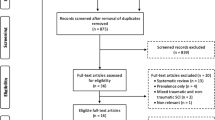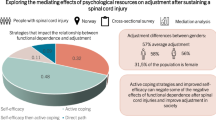Abstract
An analysis of the mortality rate of 3486 spinal injured patients treated in the early posttraumatic period in the years 1965-1989 in Konstancin, Poland is presented. The data show that the life of the spinal cord injured is threatened by several factors, the most important of which appear to be: the level and degree of the spinal cord lesion; certain causes of injury predisposing to severe nervous system injury; advanced age; and to some extent, concomitant injuries and methods of treatment. The significance of age is demonstrated by a nearly tenfold increase in mortality in the oldest age group of patients with complete spinal cord lesions as compared to the youngest age group of up to 20 years with the same degree of spinal cord damage.
Similar content being viewed by others
Log in or create a free account to read this content
Gain free access to this article, as well as selected content from this journal and more on nature.com
or
References
Kamalow I L (1978) Cause of death in severe trauma of spine and spinal cord. Klin Khir 2: 74–79.
Kurtzke J F (1975) Epidemiology of spinal cord injury. Exper Neurol 48: 163–236.
Le C T, Price M (1982) Survival from spinal cord injury. J Chron Dis 35: 487–492.
Kraus J F, Franti C h E, Borham N O, Riggins R S (1979) Survival with an acute spinal cord injury. J Chron Dis 32: 269–283.
Mesars L, Carmody A, Mannarino E, Ruge D (1978) Survival after spinal cord trauma. A life table analysis. Arch Neurol 35: 78–83.
Sneddon D G, Bedbrook G (1982) Survival following traumatic tetraplegia. Paraplegia 20: 201–207.
Jäger M (1979) Spinal damages in old age and their therapy. Dutch Med J 21: 1223–1229.
Rossier A C, Bors E (1965) Problems of the aged with spinal cord injuries. Paraplegia 3: 34–39.
Kiwerski J (1992) Respiratory problems in patients with quadriplegia. Int J Rehabil Res 15: 1.
Kiwerski J (1989) The natural history of neurological recovery in patients with tetraplegia. Paraplegia 27: 41–45.
Fugl-Meyer A R, Grimby G (1971) Ventilatory function in tetraplegic patients. Scand J Rehabil Med 3: 151–160.
Huldtgren A C, Fugl-Meyer A R, Jonasson E, Bake B (1989) Ventilatory dysfunction and respiratory rehabilitation in post-traumatic quadriplegia. Eur J Respir Dis 61: 347–356.
Mackenzie C F, Shin B, Krishnaprasa D (1985) Assessment of cardiac and respiratory function during surgery of patients with acuate quadriplegia. J Neurosurg 62: 843–849.
Haas F, Axen K, Pinenda H (1985) Temporal pulmonary function changes in cervical cord injury. Arch Phys Med Rehabil 66: 139–144.
Kiwerski J (1986) Injuries of upper cervical spine. Int J Rehabil Res 9: 272–276.
McMichan J C, Michel L, Westbrook R R (1980) Pulmonary dysfunction following traumatic quadriplegia. JAMA 243: 528–31.
Simpson D (1981) Fatal injuries of the head and spine. Epidemiological studies. Med J Aust 2: 660–664.
Wagner K A, Kopaniky D R, Esposito L (1983) Head and spinal cord injured patients: impact of combined sequelae. Arch Phys Med Rehabil 64: 519–524.
Wilmot C B, Cope D N, Hall K M (1985) Occult head injury: its incidence in spinal cord injury. Arch Phys Med Rehabil 66: 227–231.
Charney K J, Juler G L, Commarr A G (1975) General surgery problems in patients with spinal cord injuries. Arch Surg 110: 1083–1088.
Sonderstrom C A, McArdle D O, Ducker T h B (1983) The diagnosis of intra-abdominal injury in patients with cervical cord trauma. J Trauma 23: 1061–1065.
Kiwerski J (1986) Bleedings of alimentary duct in the course of treatment of spinal cord injury. Paraplegia 24: 92–96.
Author information
Authors and Affiliations
Rights and permissions
About this article
Cite this article
Kiwerski, J. Factors contributing to the increased threat to life following spinal cord injury. Spinal Cord 31, 793–799 (1993). https://doi.org/10.1038/sc.1993.122
Issue date:
DOI: https://doi.org/10.1038/sc.1993.122



